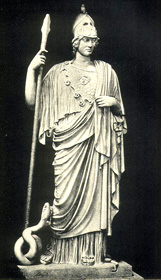Iron Age Europe
Ancient Greece and Roman Bath
Classical Athens | Roman Britain
Statues from classical Greece and Rome show the goddess Athene with a python at her feet.
'It is possible that the goddess Athene can trace her roots to the Minoan goddess of a millennium before classical times,' said Miranda. 'Athens might have resisted all the invasions that overtook other city states during the Greek Dark Ages and found herself able to preserve many things from the Mycenaean age. In the dim inner sanctuary of the Parthenon, Phidias’s towering statue of Athena was of gleaming ivory and gold. Half hidden in the shadow behind her golden shield lurked a bronze-green python.
And there are other statues from classical times that show her with this python.


‘Athene wasn't the first Greek goddess to be associated with a snake in Greek mythology,' replied Quintin. 'The Gorgon Medusa had snakes for hair. She lived with her two sisters at the edge of Night, near to where the Hesperides guarded the Apples of Immortality in the Gardens of the Hesperides far to the west, according to Hesiod. Some ancient writers believed that these gardens lay in the land of the Hyperborians, which might have been Britain.
‘Then have a look at this,’ said Miranda, clicking onto a website that she had already saved in a tab. ‘This was carved by Roman Britons at the Roman baths at Bath. It is likely to be an old British deity glancing back to the times before the Roman invasion. A god with snakes for hair!’
